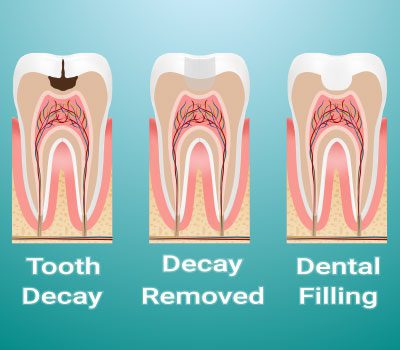Treat Cavities & Restore Your Smile
Tooth Colored Fillings
Got a cavity? Our dentist can fix it with special fillings called composites. They’ll make your teeth healthy again by filling the tiny holes and protecting them from damage.

Dental Fillings
- What Steps Are Involved in Filling a Tooth?
- Understanding Composite Fillings
- Replace old work with tooth coloured fillings
- Other Filling Types
- Does Dental Insurance Cover the Cost of Composites?
- What’s a Temporary Filling and Why Would I Need One?
- Problems With Dental Fillings
What Steps Are Involved in Filling a Tooth?
First, the dentist numbs the area around the affected tooth. They then remove the decay from the tooth. The choice of instrument depends on the dentist’s training. Next, once the decay has been removed, the dentist will clean the cavity of bacteria and debris. If the decay is near the root, your dentist may first put in a liner to protect the nerve. Finally, we apply the tooth-colored material in layers. We use a special light that “cures” or hardens each layer. The dentist will shape the composite material to the desired result. Excess material is trimmed off. Generally, after the filling is in, your dentist will finish and polish it.
Understanding Composite Fillings
The New Standard For Filling Cavities
In the past, amalgam was used for filling teeth. This has silver, tin, copper, and mercury. Metal amalgam resists wear and tear, but it is also grayish in color. This does not match your natural teeth well. Alternatively, composite fillings comprise a special dental resin. This is strong and durable. We try to match this material to the exact color of your tooth enamel. At our offices, we repair cavities with composite fillings. This is so you won’t have to worry about negatively impacting the aesthetics of your smile.
Replace Old Dental Work
With Tooth-Colored Fillings
In the old days, folks used a mix called amalgam to fill teeth. It had silver, tin, copper, and mercury. Even though it was strong, it looked gray and didn’t match real teeth well. But now, we have special fillings called composites. They’re made from a strong material and come in the same color as your teeth. When we fix holes in your teeth with these fillings, we make sure they look just like your natural teeth. So, if you choose these fillings at our office, your smile will stay looking nice, and you won’t need to worry about it.
What Types of Filling Materials Are Available?
Filling-materials
Dentists use different stuff to fix teeth, like silver and gold. But we like to use materials that match your teeth, like plastic and composite resin. Some have glass and fluoride, and we call those glass ionomers. They’re kind of like composites and help fix teeth too.

